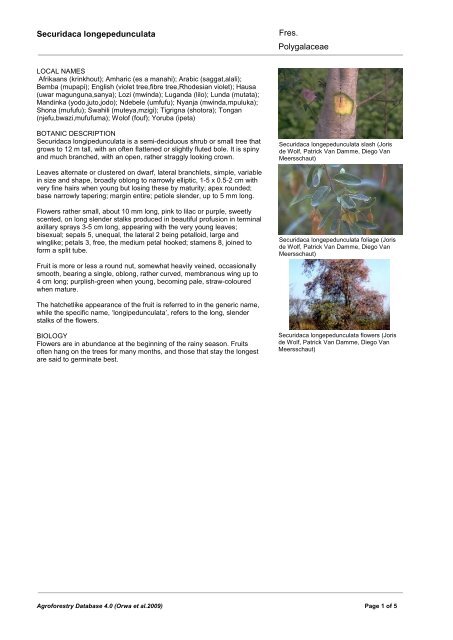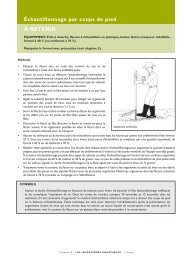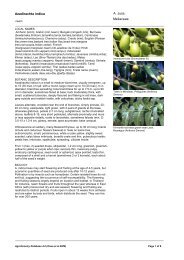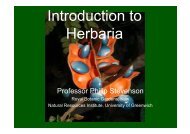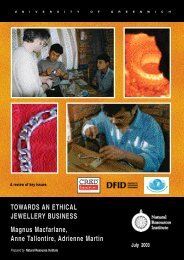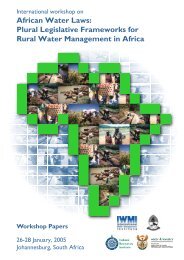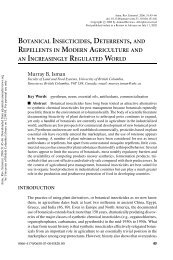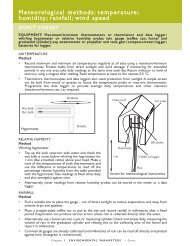Securidaca longepedunculata fact sheet
Securidaca longepedunculata fact sheet
Securidaca longepedunculata fact sheet
You also want an ePaper? Increase the reach of your titles
YUMPU automatically turns print PDFs into web optimized ePapers that Google loves.
<strong>Securidaca</strong> <strong>longepedunculata</strong><br />
LOCAL NAMES<br />
Afrikaans (krinkhout); Amharic (es a manahi); Arabic (saggat,alali);<br />
Bemba (mupapi); English (violet tree,fibre tree,Rhodesian violet); Hausa<br />
(uwar magunguna,sanya); Lozi (mwinda); Luganda (lilo); Lunda (mutata);<br />
Mandinka (yodo,juto,jodo); Ndebele (umfufu); Nyanja (mwinda,mpuluka);<br />
Shona (mufufu); Swahili (muteya,mzigi); Tigrigna (shotora); Tongan<br />
(njefu,bwazi,mufufuma); Wolof (fouf); Yoruba (ipeta)<br />
BOTANIC DESCRIPTION<br />
<strong>Securidaca</strong> longipedunculata is a semi-deciduous shrub or small tree that<br />
grows to 12 m tall, with an often flattened or slightly fluted bole. It is spiny<br />
and much branched, with an open, rather straggly looking crown.<br />
Leaves alternate or clustered on dwarf, lateral branchlets, simple, variable<br />
in size and shape, broadly oblong to narrowly elliptic, 1-5 x 0.5-2 cm with<br />
very fine hairs when young but losing these by maturity; apex rounded;<br />
base narrowly tapering; margin entire; petiole slender, up to 5 mm long.<br />
Flowers rather small, about 10 mm long, pink to lilac or purple, sweetly<br />
scented, on long slender stalks produced in beautiful profusion in terminal<br />
axillary sprays 3-5 cm long, appearing with the very young leaves;<br />
bisexual; sepals 5, unequal, the lateral 2 being petalloid, large and<br />
winglike; petals 3, free, the medium petal hooked; stamens 8, joined to<br />
form a split tube.<br />
Fruit is more or less a round nut, somewhat heavily veined, occasionally<br />
smooth, bearing a single, oblong, rather curved, membranous wing up to<br />
4 cm long; purplish-green when young, becoming pale, straw-coloured<br />
when mature.<br />
The hatchetlike appearance of the fruit is referred to in the generic name,<br />
while the specific name, ‘longipedunculata’, refers to the long, slender<br />
stalks of the flowers.<br />
BIOLOGY<br />
Flowers are in abundance at the beginning of the rainy season. Fruits<br />
often hang on the trees for many months, and those that stay the longest<br />
are said to germinate best.<br />
Agroforestry Database 4.0 (Orwa et al.2009)<br />
Fres.<br />
Polygalaceae<br />
<strong>Securidaca</strong> <strong>longepedunculata</strong> slash (Joris<br />
de Wolf, Patrick Van Damme, Diego Van<br />
Meersschaut)<br />
<strong>Securidaca</strong> <strong>longepedunculata</strong> foliage (Joris<br />
de Wolf, Patrick Van Damme, Diego Van<br />
Meersschaut)<br />
<strong>Securidaca</strong> <strong>longepedunculata</strong> flowers (Joris<br />
de Wolf, Patrick Van Damme, Diego Van<br />
Meersschaut)<br />
Page 1 of 5
<strong>Securidaca</strong> <strong>longepedunculata</strong><br />
Fres.<br />
Polygalaceae<br />
ECOLOGY<br />
Found in a wide range of climates, from subtropical, hot and arid climate to summer rainfall and equatorial humid.<br />
Occurs in a broad range of vegetation, from semi-arid scrub to dense forest, including many woodland and bush habitats<br />
and gallery forests. S. longipedunculata is resistant to bush fires and is frost sensitive.<br />
BIOPHYSICAL LIMITS<br />
Altitude: 0-1 800 m, Mean annual rainfall: 600-1 000 mm<br />
Soil type: Usually acid and sandy or rocky.<br />
DOCUMENTED SPECIES DISTRIBUTION<br />
Native:<br />
Exotic:<br />
Angola, Benin, Botswana, Burundi, Cameroon, Chad, Cote d'Ivoire, Democratic Republic of Congo,<br />
Eritrea, Ethiopia, Gambia, Ghana, Guinea, Kenya, Malawi, Mali, Mozambique, Namibia, Niger,<br />
Nigeria, Rwanda, Senegal, Sierra Leone, South Africa, Sudan, Tanzania, Uganda, Zambia,<br />
Zimbabwe<br />
Native range<br />
Exotic range<br />
The map above shows countries where the species has been planted. It does neither<br />
suggest that the species can be planted in every ecological zone within that country,<br />
nor that the species can not be planted in other countries than those depicted. Since<br />
some tree species are invasive, you need to follow biosafety procedures that apply to<br />
your planting site.<br />
Agroforestry Database 4.0 (Orwa et al.2009)<br />
Page 2 of 5
The map above shows countries where the species has been planted. It does neither<br />
suggest that the species can be planted in every ecological zone within that country,<br />
nor that the species can not be planted in other countries than those depicted. Since<br />
Fres.<br />
some tree species are invasive, you need to follow biosafety procedures that apply to<br />
your planting site.<br />
<strong>Securidaca</strong> <strong>longepedunculata</strong><br />
PRODUCTS<br />
Food: Young leaves are eaten as a vegetable or in sauces.<br />
Polygalaceae<br />
Apiculture: Suitable for honey production as bees often frequent the flowers. In Eritrea, for example, the tree is one of<br />
the most valuable lowland honey sources, and planting to increase honey production is recommended.<br />
Fuel: S. longipedunculata can be burnt for firewood and charcoal.<br />
Fibre: Fine quality fibre is obtained from inner bark of the straight, annual shoots, which when retted could possibly be<br />
useful for flaxlike textiles. Much appreciated locally in western, central and southern Africa because of its long, durable<br />
and tough fibres. Used for making string and rope for fishing net and lines, bird and animal snares, for thread to sew<br />
bark cloth and as bead string for necklaces.<br />
Timber: Wood is pale, soft, spongy, very light, and brittle, and is regarded to have little value. Used for poles, hut<br />
construction, bows and brooms. It is resistant to termites and decay.<br />
Lipids: The flowers yield an oil with many possible uses; oil expressed from the seeds is used cosmetically or as a<br />
furniture stain.<br />
Poison: The trees, especially the roots, are a toxicity risk if taken in excess. A saponin found in the roots can cause<br />
severe damage to bone marrow and haemolysis when in contact with blood. The solid portion of the root is said to be<br />
the most lethal. The root bark also contains 0.42% methyl salicylate. Severe poisoning can result from ingestion of 10-<br />
30 ml of methyl salicylate. In Zambia the crushed and powdered roots are used as an intravaginal or intrarectal poison,<br />
and in Gambia as a fish poison. Bark, roots and seeds are used in arrow poison, and root can be used as a snake<br />
repellent. Roots at 350 ppm are 100% effective as a molluscicide.<br />
Medicine: Used in both western and southern Africa to treat widely differing ailments. Roots, in small doses (drastic<br />
and dangerous in larger doses), are purgative, diuretic, diaphoretic and emetic. They are used for eye complaints such<br />
as conjunctivitis, malaria, venereal diseases, urethral discharges, stomach problems, dysentery, rheumatism, fibrositis,<br />
toothache, headache, sleeping sickness, cough, chest complaints, snakebite, and wound dressing, and as an<br />
aphrodisiac, taenifuge, vermifuge and expectorant. An infusion of the roots is used as a mouthwash in cases of<br />
toothache and is applied to cuts on the legs to treat inflammatory conditions. Powder from the burned roots is rubbed<br />
into small incisions made on the temple and forehead to relieve headaches. Seeds are used for headache, fever and<br />
rheumatism; leaves for snakebite, venereal diseases and coughs; bark for stomach problems and as an arrow poison<br />
antidote.<br />
Other products: Due to the presence of saponins, bark, root bark and crushed seeds give a soapy solution in water and<br />
are used as soap for washing or bleaching clothes.<br />
SERVICES<br />
Ornamental: S. longipedunculata is a beautiful flowering tree with potential as an ornamental in parks and gardens.<br />
Agroforestry Database 4.0 (Orwa et al.2009)<br />
Page 3 of 5
<strong>Securidaca</strong> <strong>longepedunculata</strong><br />
Fres.<br />
TREE MANAGEMENT<br />
Plants should be well watered in the summer but are more tolerant to drought in winter.<br />
Polygalaceae<br />
GERMPLASM MANAGEMENT<br />
Seed can retain viability for a long period at room temperature if kept dry. There are about 36 000 seeds/kg.<br />
Agroforestry Database 4.0 (Orwa et al.2009)<br />
Page 4 of 5
<strong>Securidaca</strong> <strong>longepedunculata</strong><br />
FURTHER READNG<br />
Beentje HJ. 1994. Kenya trees, shrubs and lianas. National Museums of Kenya.<br />
Fres.<br />
Polygalaceae<br />
Bein E. 1996. Useful trees and shrubs in Eritrea. Regional Soil Conservation Unit (RSCU), Nairobi, Kenya.<br />
Booth FEM, Wickens GE. 1988. Non-timber uses of selected arid zone trees and shrubs in Africa. FAO Conservation<br />
Guide. No. 19. Rome.<br />
Cmelik SHW and Ley H. Some constituents from the root bark of the African violet tree (<strong>Securidaca</strong> longipedunculata<br />
Fres.). Transactions of the Zimbabwe Scientific Association. 62(5):28-32.<br />
Coates-Palgrave K. 1988. Trees of southern Africa. C.S. Struik Publishers Cape Town.<br />
Dale IR, Greenway PJ. 1961. Kenya trees and shrubs. Buchanan’s Kenya Estates Ltd.<br />
Drummond BR. 1981. Common trees of the Central Watershed Woodlands of Zimbabwe. National Resources Board.<br />
Eggeling. 1940. Indigenous trees of Uganda. Govt. of Uganda.<br />
Katende AB et al. 1995. Useful trees and shrubs for Uganda. Identification, Propagation and Management for<br />
Agricultural and Pastoral Communities. Regional Soil Conservation Unit (RSCU), Swedish International Development<br />
Authority (SIDA).<br />
Leeuwenberg AJM. 1987. Medicinal and poisonous plants of the tropics. Pudoc Wageningen.<br />
Mbuya LP et al. 1994. Useful trees and shrubs for Tanzania: Identification, Propagation and Management for<br />
Agricultural and Pastoral Communities. Regional Soil Conservation Unit (RSCU), Swedish International Development<br />
Authority (SIDA).<br />
Storrs AEG. 1995. Know your trees: some common trees found in Zambia. Regional Soil Conservation Unit (RSCU).<br />
Tietema T, Merkesdal E and Schroten J. 1992. Seed germination of indigenous trees in Botswana. Acts Press.<br />
SUGGESTED CITATION<br />
Orwa C, Mutua A , Kindt R , Jamnadass R, Simons A. 2009. Agroforestree Database:a tree reference and selection guide<br />
version 4.0 (http://www.worldagroforestry.org/af/treedb/)<br />
Agroforestry Database 4.0 (Orwa et al.2009)<br />
Page 5 of 5


